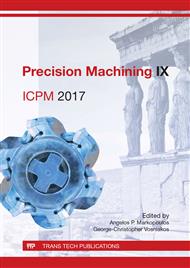[1]
B.J. Alder and T.E. Wainwright, Studies in molecular dynamics. I. general method, Journal of Chemical Physics 3 (1959) 459-466.
Google Scholar
[2]
J. Belak, and I.F. Stowers, A molecular dynamics model of the orthogonal cutting process, Proceedings of the American Society of Precision Engineering (1990) 76-79.
Google Scholar
[3]
J. Belak, and I.F. Stowers, The indentation and scratching of a metal surface: A molecular dynamics study, Fundamentals of Friction: Macroscopic and Microscopic, Singer, Pollock E, 220 (1991) 1-10.
DOI: 10.1007/978-94-011-2811-7_25
Google Scholar
[4]
A. O. Oluwajobi and X. Chen, The effect of interatomic potentials on the molecular dynamics simulation of nanometric machining, Int. J. of Automation and Computing 8 (3) (2011) 326-332.
DOI: 10.1007/s11633-011-0588-y
Google Scholar
[5]
S. Kim, Issues on the choice of a proper time step in molecular dynamics, Physics Procedia 53 (2014) 60-62.
DOI: 10.1016/j.phpro.2014.06.027
Google Scholar
[6]
S.K. Gray, D.W. Noid and B.G. Sumpter, Symplectic integrators forlarge scale molecular dynamics simulations : A comparison of several explicit methods, J. Chem. Phys. 101 (5) (1994) 4062-4072.
DOI: 10.1063/1.467523
Google Scholar
[7]
J-I Choe and B. Kim, Determination of proper time step for molecular dynamics simulation, Bull Korean Chem. Soc. 21 (4) (2000) 419-424.
Google Scholar
[8]
D.D. Cui, K. Mylvaganam and L.C. Zhang and W.D. Liu, Some critical issues for a reliable molecular dynamics simulation of nano-machining, Computational Material Science 90 (2014) 23-31.
DOI: 10.1016/j.commatsci.2014.03.063
Google Scholar
[9]
S.N. Shimada, N. Ikawa, H. Tanaka, G. Ohmori and J. Uchikoshi, Feasibility study on ultimate accuracy in microcutting using molecular dynamics simulation, Annals of the CIRP, 42 (1) (1993) 91-94.
DOI: 10.1016/s0007-8506(07)62399-3
Google Scholar
[10]
L. Verlet, Computer experiments on classical fluids I. thermodynamics properties of Lennard-Jones molecules, Physical Review D, 159 (1967) 98-103.
DOI: 10.1103/physrev.159.98
Google Scholar
[11]
A. Rahman, Correlations in the motions of atoms in liquid argon, Physical Review A 136 (1964) 405-411.
Google Scholar
[12]
C.W. Gear and K.W. Tu, The effect of variable mesh size on the stability of multistep methods, SIAM Journal of Numerical Analysis, 11 (5) (1974) 1025-1043.
DOI: 10.1137/0711079
Google Scholar
[13]
C.W. Gear and D.S. Watanabe, Stability and convergence of variable order \multistep methods, SIAM Journal of Numerical Analysis 11 (5) (1974) 1044-1058.
DOI: 10.1137/0711080
Google Scholar
[14]
D. Beeman, Some multistep methods for use in molecular dynamics calculations, Journal of Computational Physics 20 (1976) 130-139.
DOI: 10.1016/0021-9991(76)90059-0
Google Scholar
[15]
W.F. Van Gunsteren and H.J.C. Berendsen (1990), Computer simulation of molecular dynamics: methodology, applications, and perspectives in chemistry, Anew. Chem. Int. Ed. Engl., 29 (1990) 992-1023.
DOI: 10.1002/anie.199009921
Google Scholar
[16]
Q.X. Pei, C. Lu, H.P. Lee and Y.W. Zhang, Study of materials deformation in nanometric cutting by large-scale molecular dynamics simulation, Nanoscale Res. Lett. 4 (2009) 444-451.
DOI: 10.1007/s11671-009-9268-z
Google Scholar
[17]
D.D. Cui, K. Mylvaganam and L.C. Zhang, Nano-grooving on copper by nano-milling and nano-cutting, Advanced Mat. Res. 325 (2011) 576-581.
DOI: 10.4028/www.scientific.net/amr.325.576
Google Scholar
[18]
Y. Huang and W. Zong, Molecular dynamics simulation for nanometric cutting of single-crystal face-centred cubic metals Nanoscale Res. Lett 9 (2014) 622-630.
DOI: 10.1186/1556-276x-9-622
Google Scholar
[19]
Y-B. Guo and Y-C. Liang, Atomistic simulation of thermal effects and defect structures during nanomachining of copper, Trans, Nonferrous Mat. Soc. Chem 22 (2012) 2762-2770.
DOI: 10.1016/s1003-6326(11)61530-6
Google Scholar
[20]
L. Zhang, H. Huang, H. Zhao, Z. Ma, Y. Yang and X. Hu, The Evolution of machining induced surface of single crystal FCC copper via nanoindentation, Nanoscale Res. Lett. 8 (2013) 211-223.
DOI: 10.1186/1556-276x-8-211
Google Scholar
[21]
A.P. Markopoulous, K-A. L. Kelteremidou and D.E. Manolakos, Simulation of Nanoscale cutting with molecular dynamics, American J. of Nanotechnology 5 (2) (2014) 17-26.
Google Scholar
[22]
Z. Tong, Y. Liang, X. Jiang and X. Luo, An atomistic investigation on the mechanism of machining nanostructures when using single tip and multi-tip diamond tools' Applied Surface Science 290 (2014) 458-465.
DOI: 10.1016/j.apsusc.2013.11.113
Google Scholar
[23]
G. Jiang-hua, Z. Chun-tao, W. Ya-ping, S. Xiu-lin and G. Yong-bo, Simulation analysis of the effects of tool rake angle for workpiece temperature in single crystal copper nanometric cutting process, International Jour. of Hybrid Inf. Tech. 9 (3) (2016).
DOI: 10.14257/ijhit.2016.9.3.38
Google Scholar
[24]
M. Lai, X. Zhang, F. Fang, Y. Wang, M. Feng and W. Tian, Study on nanometric cutting of germanium by molecular dynamics, Nano. Res. Lett. 8 (2013) 13-22.
DOI: 10.1186/1556-276x-8-13
Google Scholar
[25]
L-Q. Shi, J-X. Xie, M.D. Xi, X-H. Li and F. Yu, Study on cutting mechanism of monocrystalline silicon using molecular dynamics on nanometric scale, Intl. Conf. on Materials science and Appl. (ICMSA 2015) 117-120.
DOI: 10.2991/icmsa-15.2015.22
Google Scholar
[26]
Hwang H.J., O-K Kwon and J. W. Kang, Copper nanocluster diffusion in carbon nanotube, Solid St. Comm. 129 (2004) 687-690.
DOI: 10.1016/j.ssc.2003.12.033
Google Scholar
[27]
J. Tersoff, Empirical interatomic potential for silicon with improved elastic properties, Physical Review B 38 (14) (1988) 9902-9905.
DOI: 10.1103/physrevb.38.9902
Google Scholar
[28]
H. Raffi-Tabar and G.A. Mansoori, Interatomic potential models for nanostructures in: H.S. Nalwa (ed. ), Encyclopedia of Nanoscience and Nanotechnology, American Scientific Publishers, X, 2003, pp.1-17.
Google Scholar
[29]
S.J. Plimpton, Fast parallel algorithms for short-range molecular dynamics, Journal Comp. Phys. 117 (1995) 1- 19 and www. lammps. sandia. gov.
Google Scholar


